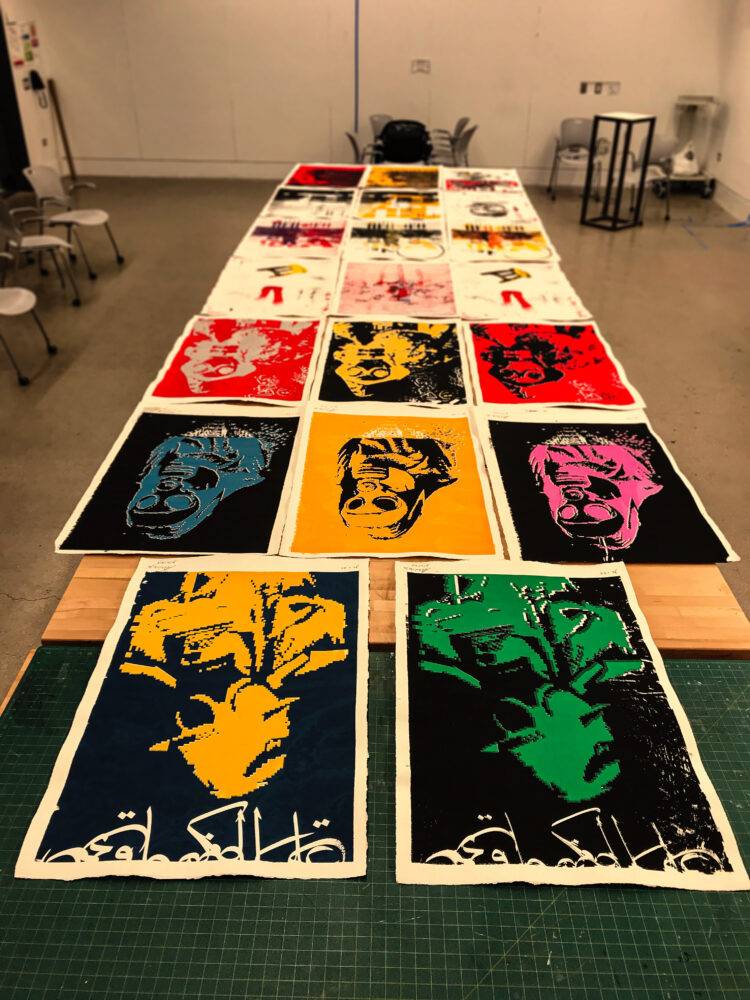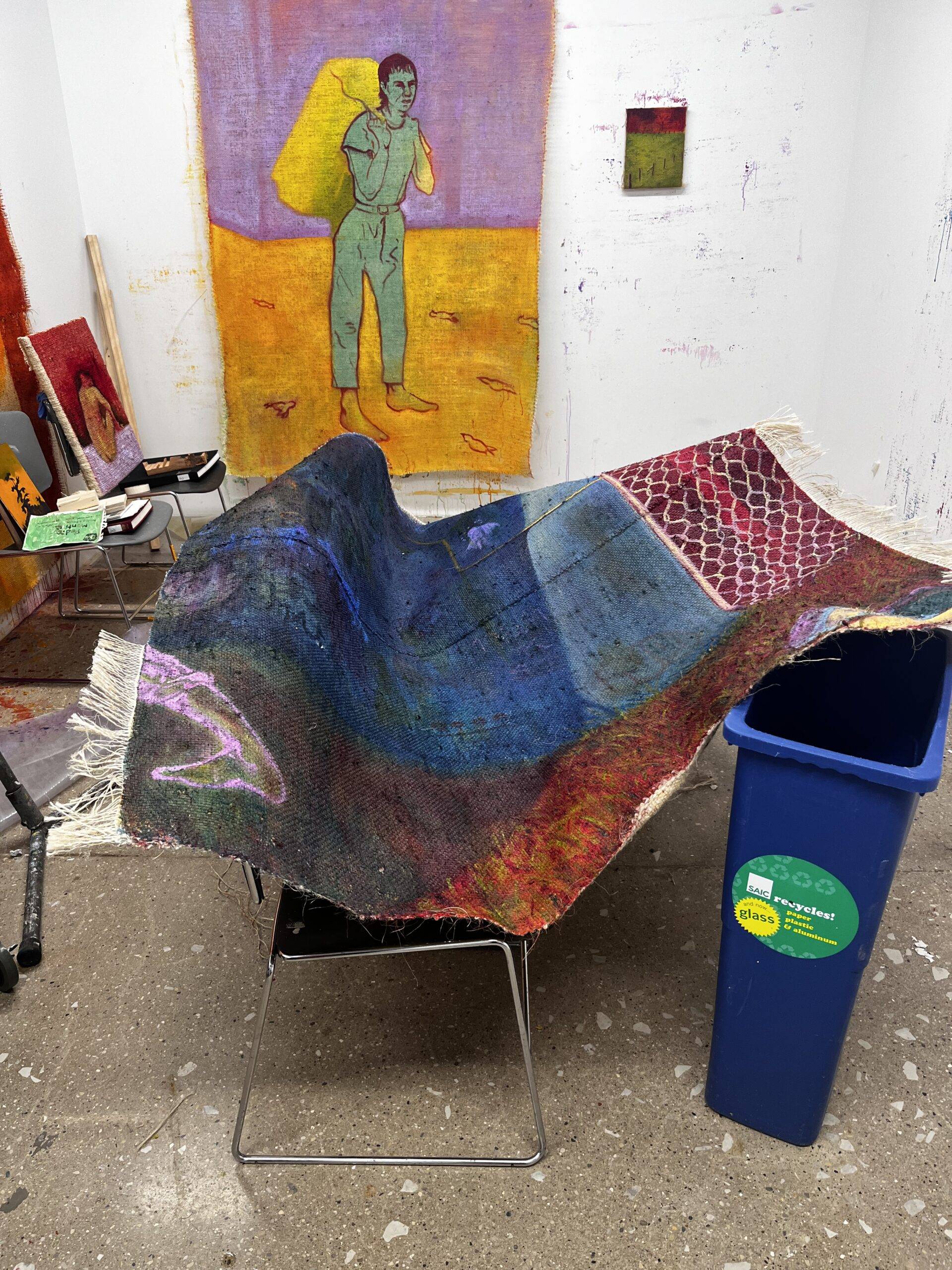
Fares Alhalabi, a second year MFA student in the Printmedia department at
the School of the Art Institute of Chicago, brings a range of experiences to his artistic journey. Originally from Syria, Alhalabi pursued his undergraduate degree in Drawing and Painting from 2008 to 2012 amidst the backdrop of Syria’s unfolding conflict, which started in 2011 with an uprising against the then regime.
Even as an undergraduate student in Syria Alhalabi knew he wanted to attend SAIC for graduate school. At that time, however, he wasn’t aware that this journey would be more than just a pursuit of academic excellence. It also became an escape from the turbulent events gripping his homeland.

In his work, primarily centered around printmaking, Alhalabi draws inspiration from various sources, including publicly accessible imagery found on the internet. He juxtaposes these images with text, often rendering them illegible or stripped of meaning, to explore the nuances of propaganda and the power dynamics inherent in visual communication.
Alhalabi’s artistic journey intersects with the unfolding history of the Syrian rebellion, which resulted in a full scale civil war in 2013.
In 2011, just a year before Alhalabi’s graduation, Syrian adolescents scrawled anti-regime graffiti on public walls. They were arrested, held for days and tortured, in turn prompting demonstrations calling for their release. The government forces suppressed these protests with violent crackdowns and arrests, leading to widespread destruction and displacement of civilians.

“I was absorbing all the effects of the war; losing close friends to the explosions; it was tough,” Alhalabi said, reflecting on the impact of the conflict on his life and artistic expression.
In 2013, Alhalabi made the difficult decision to flee his homeland, seeking refuge in the United States.
But his journey had just begun. Despite his academic aspirations and excellence, Alhalabi found himself navigating the complexities of the U.S. immigration system, spending years waiting for an interview that should have taken 180 days — the stated standard.
“Everything was different. I did not speak the language very well,” Alhalabi said. “But I knew my goal was to go to the dream school.”
He did not have the financial capacity to attend SAIC. As a non-citizen, Alhalabi was ineligible for government loans or other types of aid.
It took him nine years of perseverance, working various jobs at factories and restaurants to accumulate the funds needed to fulfill his dream of attending SAIC.
Beyond Alhalabi’s personal narrative lies the broader context of Syria’s ongoing struggle. The rebellion that erupted in 2011 has since spiraled into a protracted conflict. The Syrian regime’s brutal crackdown on dissent marked by war crimes and human rights violations, has drawn international condemnation and has been met with consequences like imposed sanctions by entities such as the United States.
Yet, as Alhalabi has observed, these sanctions, while aimed to be directed at the regime, often exacerbate the suffering of ordinary Syrians and impede the flow of humanitarian aid in one of the most vulnerable countries in the world.
The Turkey-Syrian earthquake in 2023 served as a stark reminder of the country’s fragility. 50,000 buildings were completely destroyed and 265,000 people left in urgent need of housing. This fragility was further compounded by the challenges of accessing international assistance amidst sanctions and bureaucratic hurdles.
Challenging the common belief, Alhalabi believes that the earthquake wasn’t the only reason for destruction. “These buildings would have collapsed anyway because people in the buffer zone were living in extremely poor conditions,” he said.
The “buffer zone” was established by Turkey in collaboration with rebel groups in Northern Syria. In addition to limited basic services such as clean water, sanitation and electricity, healthcare in this zone was rudimentary. These insecurities made daily life precarious, also taking a toll on the mental health of the residents.
Amid the impact of international response, and the internal complexities in Syria, artists like Alhalabi find themselves grappling with the dual imperatives of artistic expression and political engagement. For many, the act of creating art becomes a form of resistance, a means of bearing witness to the condition of their people, and for demanding accountability. Alhalabi says that his being in the U.S. makes him feel more responsible for speaking up, for documenting. “I have to speak, especially being in an influential school like this,” he said.
Navigating the complexities of political art in a context fraught with censorship and repression poses many challenges. Artists are made to reckon with questions of representation, ethical responsibility, and the risks inherent in speaking truth to power.
In the fall semester, Alhalabi created an artist book he titled “Ghaza” (Gaza), using news headlines along with images of Gazan journalists acquired from the internet.
“We are lucky to live in this time when we have social media,” he said. “Coming from the Middle East, I know how difficult it has been getting the people’s narrative out to international communities.”
Alhalabi also said he believes it his moral responsibility to “remember Palestine and talk about it.” As of this writing, more than 29,000 Palestinians have been killed and more than 69,000 wounded by the Israeli forces.
He believes that his presence here can do a lot of work. For Alhalabi, human interaction and connection can trespass all borders, bureaucracy, and propaganda.







